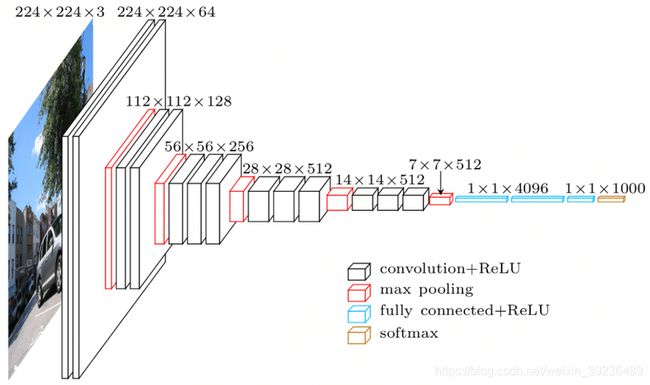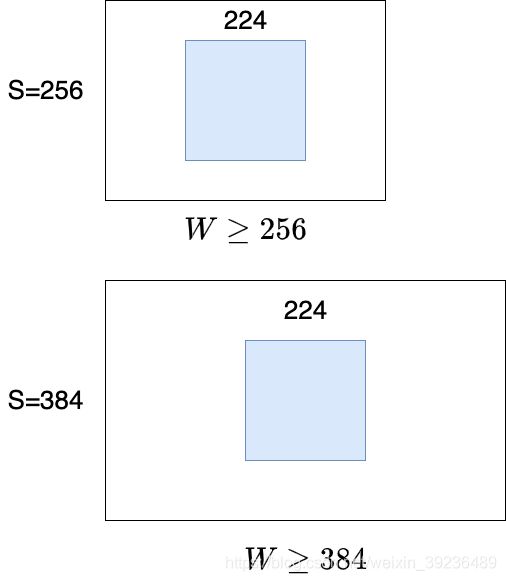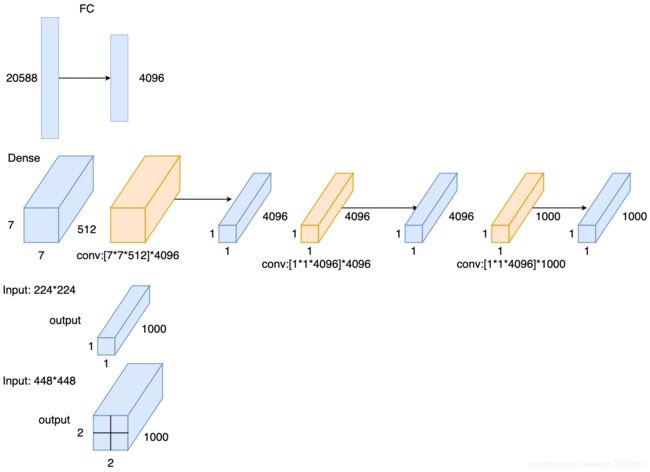【CV-baseline】02VGG-论文笔记
论文标题:Very deep convolutional networks forlarge-scale image recognition(大规模图像识别的深度卷积神经网络)
论文作者: Karen Simonyan & Andrew Zisserman
单位:VGG(牛津大学视觉几何组)
发表会议及时间:ICLR 2015
学习目标
- 模型结构设计
- 小卷积核
- 堆叠使用卷积核
- 分辨率减半,通道数翻倍
- 训练技巧
- 尺度扰动
- 预训练模型初始化
- 测试技巧
- 多尺度测试
- Dense测试
- Multi-crop测试
- 多模型融合
- 多尺度测试
论文导读
背景、成果和意义
背景
-
ILSVRC-2014
-
相关研究
-
AlexNet: 借鉴卷积模型结构
-
ZFNet: 借鉴其采用小卷积核思想
-
OverFeat: Dense test, 借鉴全卷积,实现了高效的稠密预测
-
重复使用中间像素
-
多重feature map提高了分辨率
-
-
NIN:尝试 1 × 1 1\times 1 1×1卷积
-
成果
- ILSVRC定位冠军,分类亚军
- 开源VGG16, VGG19.
意义
- 开启小卷积核, 3 × 3 3\times 3 3×3卷积核成为主流模型
- 深度卷积模型时代。 作为各类图像任务的骨干网络结构:分类、定位、检测、分割一系列图像任务大都有VGG为骨干网络的尝试
论文泛读
摘要
- 本文主题:在大规模图像识别任务中,探究卷积网络深度对分类准确率的影响
- 主要工作:研究3*3卷积核增加网络模型深度的卷积网络的识别性能,同时将模型加深到16-19层
- 本文成绩:VGG在ILSVRC-2014获得了定位任务冠军和分类任务亚军
- 泛化能力:VGG不仅在ILSVRC获得好成绩,在别的数据集中表现依旧优异
- 开源贡献:开源两个最优模型,以加速计算机视觉中深度特征表示的进一步研究
越靠后的卷积层利用非线性更强的操作,后面的卷积核数量更多
VGG结构
文中展示了总共六种模型:A, A-LRN, B, C, D, E
模型共性:
- 5个maxpool
- maxpool之后,特征图通道数翻倍直至512
- 3个FC层进行分层输出
- maxpool之间采用多个卷积层堆叠,对特征进行提取和抽象
- 都是从11层权重层(weight layers)开始堆叠。借鉴Goodfellow的论文(Goodfellow et al. (2014) applied deep ConvNets (11 weight layers) to the task of street number recognition)
演变过程
- A:11层卷积
- A-LRN:基于A增加一个LRN
- B: 第1,2个block中增加1个卷积33卷积
- C: 第3, 4, 5个block分别增加1个 1 × 1 1\times1 1×1卷积, 表明增加非线性有益于指标提升
- D:第3, 4, 5个block的 1 × 1 1\times 1 1×1卷积替换为 3 × 3 3\times3 3×3,
- E: 第3, 4, 5个block再分别增加1个 3 × 3 3\times 3 3×3卷积
参数量对比
VGG16 结构
网络层维度
这里经历了5次maxpool,就意味着输入张量(假设 224 × 224 224\times 224 224×224)的宽和高的维度减半了5次,所以最后的输出维度是
224 2 5 = 7 \dfrac{224}{2^{5}}=7 25224=7
也就是图中 7 × 7 × 512 7\times 7\times 512 7×7×512,然后flatten成一个 1 × 25088 1\times 25088 1×25088维度的向量,连接后面的4096
【VGG-16和VGG-19差别在哪?
答:VGG 中定义了6种模型结构A~E,C模型 和D 模型都包含16 个权重层,其中C 模型是在第7 个卷积层使用 1 × 1 1\times 1 1×1的卷积核,第3,4,5个block分别增加1层 1 × 1 1\times 1 1×1卷积,作者使用 1 × 1 1\times 1 1×1卷积核是为了增加模型的非线性,提升模型指标;D 模型将3,4,5个block的 1 × 1 1\times 1 1×1卷积核替换为 3 × 3 3\times 3 3×3卷积核,D模型和C模型 卷积核的数量都相等,现在pytorch 的官方定义的VGG 16 的模型中是D模型结构;E模型即VGG19,相比D模型和C模型,在第3,4,5个block再分别增加1层3*3卷积, 分别为conv3-256、conv3-512、conv3-512】
VGG 特点
堆叠 3 × 3 3\times 3 3×3卷积核
增大感受野
2个 3 × 3 3\times 3 3×3堆叠等价于1个 5 × 5 5\times 5 5×5
(图片来源: https://www.jeremyjordan.me/convnet-architectures/)
3个 3 × 3 3\times 3 3×3堆叠等价于1个 7 × 7 7\times 7 7×7
其他作用
- 增加非线性激活函数,增强了特征抽象能力
- 减少了训练参数
- 可看成 7 × 7 7\times 7 7×7卷积核的正则化,强迫 7 × 7 7\times 7 7×7分解为 3 × 3 3\times 3 3×3
例子:假设输入,输出通道均为C个通道
一个 7 × 7 7\times 7 7×7卷积核所需的参数量: 7 × 7 × C × C = 49 C 2 7\times 7 \times C \times C=49C^2 7×7×C×C=49C2,3个 3 × 3 3\times 3 3×3卷积核所需参数量为 3 × 3 × 3 × C × C = 27 C 2 3\times 3\times 3\times C \times C = 27C^2 3×3×3×C×C=27C2。参数量减少 ( 49 − 27 ) 27 ≈ 44 % (49-27)27\approx44\% (49−27)27≈44%
尝试 1 × 1 1\times 1 1×1卷积
借鉴NIN,引入利用 1 × 1 1\times 1 1×1卷积, 增加非线性激活函数,提升模型效果
训练技巧
数据增强: Scale jittering
方法一:针对位置
训练阶段
- 按比例缩放图片至最小边为S
- 随机位置裁剪出 224 × 224 224\times 224 224×224区域
- 随机进行水平翻转
方法二:
修改RGB通道的像素值,实现颜色扰动
S设置方法
- 固定值:S=256, 或者S=384
- 随机值:每个batch的S在[256, 512]间随机选取,实现尺度扰动
预训练模型初始化
深度神经网络对初始化敏感
-
深度加深时,用浅层网络初始。 B,C,D,E用A模型初始化
-
Multi-scale训练时,用小尺度初始化:
- S=384时,用S=256模型初始化
- S=[256, 512]时,用S=384模型初始化
-
直接用Xavier初始化是现在的主流
测试技巧
多尺度测试
图片等比例缩放至最短边为Q。本文设置了3个Q,对图片进行预测,然后取平均
方法一:
S为固定值时, Q = [ S − 32 , S , S + 32 ] Q=[\mathrm{S}-32, \mathrm{~S}, \mathrm{~S}+32] Q=[S−32, S, S+32].比如S=256, Q=[224, 256, 288]
方法二:
S为随机值([256, 512])时, Q = ( S m i n , 0.5 × ( S m i n + S m a x ) , S m a x ) = ( 256 , 384 , 512 ) Q=\left(S_{min} , \quad 0.5 \times \left(S_{min}+S_{max} \right), \quad S_{max} \right) = (256, 384, 512) Q=(Smin,0.5×(Smin+Smax),Smax)=(256,384,512)
稠密测试(Dense test)
将FC层转换为卷积操作,变为全卷积网络,实现任意尺寸图片输入
- 输入图片经过全卷积网络得到 N × N × 1000 N\times N\times 1000 N×N×1000特征图
- 在通道维度( N × N N\times N N×N)上求和(sum pool)计算平均值,得到 1 × 1000 1\times 1000 1×1000输出向量
上图中的例子,如果原先训练时的S=256, 裁剪后的输入图片尺寸是224,那么如果Q=224输出的就是一个 1 × 1 × 1000 1\times 1\times 1000 1×1×1000的张量。如果Q=448,那么,就得到一个 2 × 2 × 1000 2\times 2\times 1000 2×2×1000的张量, 那么我们就要在通道维度上求和计算平均值得到一个 1 × 1 × 1000 1\times 1\times 1000 1×1×1000的输出向量。
multi-crop测试
借鉴AlexNet与GoogLeNet,对图片进行Multi-crop,裁剪大小为 224 × 224 224\times224 224×224,并水平翻转 1张图,缩放至3种尺寸,然后每种尺寸裁剪出50张图片; 50 = 5 × 5 × 2 50 = 5\times5\times2 50=5×5×2。那么总共三个Q值就有150张图片
因此测试分为两个steps
- Step1: 等比例蒜放图像至Q1, Q2, Q3三种尺寸
- Step2: 分别用三种方法
- Dense:全卷积,sum pool,得到 1 × 1000 1\times 1000 1×1000
- Multi-crop:多个位置裁剪224*224区域
- Multi-crop & Dense:综合取平均
实验结果及分析
single scale evaluation
S为固定值时:Q = S, S为随机值时: Q = 0.5 ( S m i n + S m a x ) Q = 0.5(S_{min} + S_{max}) Q=0.5(Smin+Smax)
结论
-
误差随深度加深而降低,当模型到达19层时,误差饱和,不再下降
-
增加 1 × 1 1\times1 1×1有助于性能提升
-
训练时加入尺度扰动,有助于性能
提升
-
B模型中, 3 × 3 3\times 3 3×3替换为 5 × 5 5\times 5 5×5卷积,top1下降7%
multi-scale evaluation
方法一:
S为固定值时, Q = [ S − 32 , S , S + 32 ] Q=[\mathrm{S}-32, \mathrm{~S}, \mathrm{~S}+32] Q=[S−32, S, S+32].比如S=256, Q=[224, 256, 288]
方法二:
S为随机值([256, 512])时, Q = ( S m i n , 0.5 × ( S m i n + S m a x ) , S m a x ) = ( 256 , 384 , 512 ) Q=\left(S_{min} , \quad 0.5 \times \left(S_{min}+S_{max} \right), \quad S_{max} \right) = (256, 384, 512) Q=(Smin,0.5×(Smin+Smax),Smax)=(256,384,512)
结论:
- 测试时采用Scale jittering有助于性能提升
multi-crop evaluation
方法: 等步长的滑动 224 × 224 224\times 224 224×224的窗口进行裁剪,在尺 度为Q的图像上裁剪 5 × 5 = 25 5\times 5=25 5×5=25张图片,然后再进 行水平翻转,得到50张图片,结合三个Q值, 一张图片得到150张图片输入到模型中
结论:
- mulit-crop优于dense
- multi-crop结合dense,可形成互补,达到最优结果
convnet confusion
方法: ILSVRC中,多模型融合已经是常规操作. ILSVRC中提交的模型为7个模型融合
采用最优的两个模型:
D/S=[256, 512]/Q=256,384, 512
E/S=[256, 512]/Q=256,384, 512
结合multi-crop和dense,得到最优结果
Comparison with the state of the art
结论: 单模型时,VGG优于冠军GoogLeNet
论文总结
关键点、创新点
- 堆叠小卷积核,加深网络
- 训练阶段,尺度扰动
- 测试阶段,多尺度及Dense+Multi crop
启发点
-
采用小卷积核,获得高精度
achieve better accuracy. For instance, the best-performing submissions to the ILSVRC- 2013 (Zeiler & Fergus, 2013; Sermanet et al., 2014) utilised smaller receptive window size and smaller stride of the first convolutional layer. (1 Introduction p2) -
采用多尺度及稠密预测,获得高精度
Another line of improvements dealt with training and testing the networks densely over the whole image and over multiple scales. (1 Introduction p2) -
1*1卷积可认为是线性变换,同时增加非线性层
In one of the configurations we also utilise 1 × 1 convolution filters, which can be seen as a linear transformation of the input channels (followed by non-linearity). (2.1 Architecture p1) -
填充大小准则:保持卷积后特征图分辨率不变【 224 / ( 2 5 ) = 7 224/(2^{5})=7 224/(25)=7】
the spatial padding of conv. layer input is such that the spatial resolution is preserved after convolution (2.1 Architecture p1) -
LRN对精度无提升
such normalisation does not improve the performance on the ILSVRC dataset, but leads to increased memory con- sumption and computation time. (2.1 Architecture p3) -
Xavier初始化可达较好效果
It is worth noting that after the paper submission we found that it is possible to initialise the weights without pre-training by using the random initialisation procedure of Glorot & Bengio (2010). (3.1 Trainning p2) -
S远大于224,图片可能仅包含物体的一部分。【这样就能保证crop出来的图片能够只包住要检测的目标物体】
S ≫ 224 the crop will correspond to a small part of the image, containing a small object or an object part (3.1 Trainning p4) -
大尺度模型采用小尺度模型初始化,可加快收敛
To speed-up training of the S = 384 network, it was initialised with the weights pre-trained with S = 256, and we used a smaller initial learning rate of 0.001. (3.1 Trainning p5) -
物体尺寸不一,因此采用多尺度训练,可以提高精度
Since objects in images can be of different size, multi scale training is beneficial to take this into account during training.(3.1 Trainning p6) -
multi crop 存在重复计算,因而低效
there is no need to sample multiple crops at test time (Krizhevsky et al., 2012), which is less efficient as it requires network re-computation for each crop.(3.2 Testing p2) -
multi crop可看成dense的补充,因为它们边界处理有所不同(?)
Also, multi-crop evaluation is complementary to dense evaluation due to different convolution boundary conditions (3.2 Testing p2) -
小而深的卷积网络优于大而浅的卷积网络
which confirms that a deep net with small filters outperforms a shallow net with larger filters. (4.1 Single scale evaluation p3) -
尺度扰动对训练和测试阶段有帮助
The results, presented in Table 4, indicate that scale jittering at test time leads to better performance(4.2 Multi scale evaluation p2)







